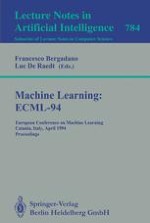This volume contains the proceedings of the European Conference on Machine Learning 1994, which continues the tradition of earlier meetings and which is a major forum for the presentation of the latest and most significant results in machine learning.
Machine learning is one of the most important subfields of artificial intelligence and computer science, as it is concerned with the automation of learning processes.
This volume contains two invited papers, 19 regular papers, and 25 short papers carefully reviewed and selected from in total 88 submissions.
The papers describe techniques, algorithms, implementations, and experiments in the area of machine learning.
